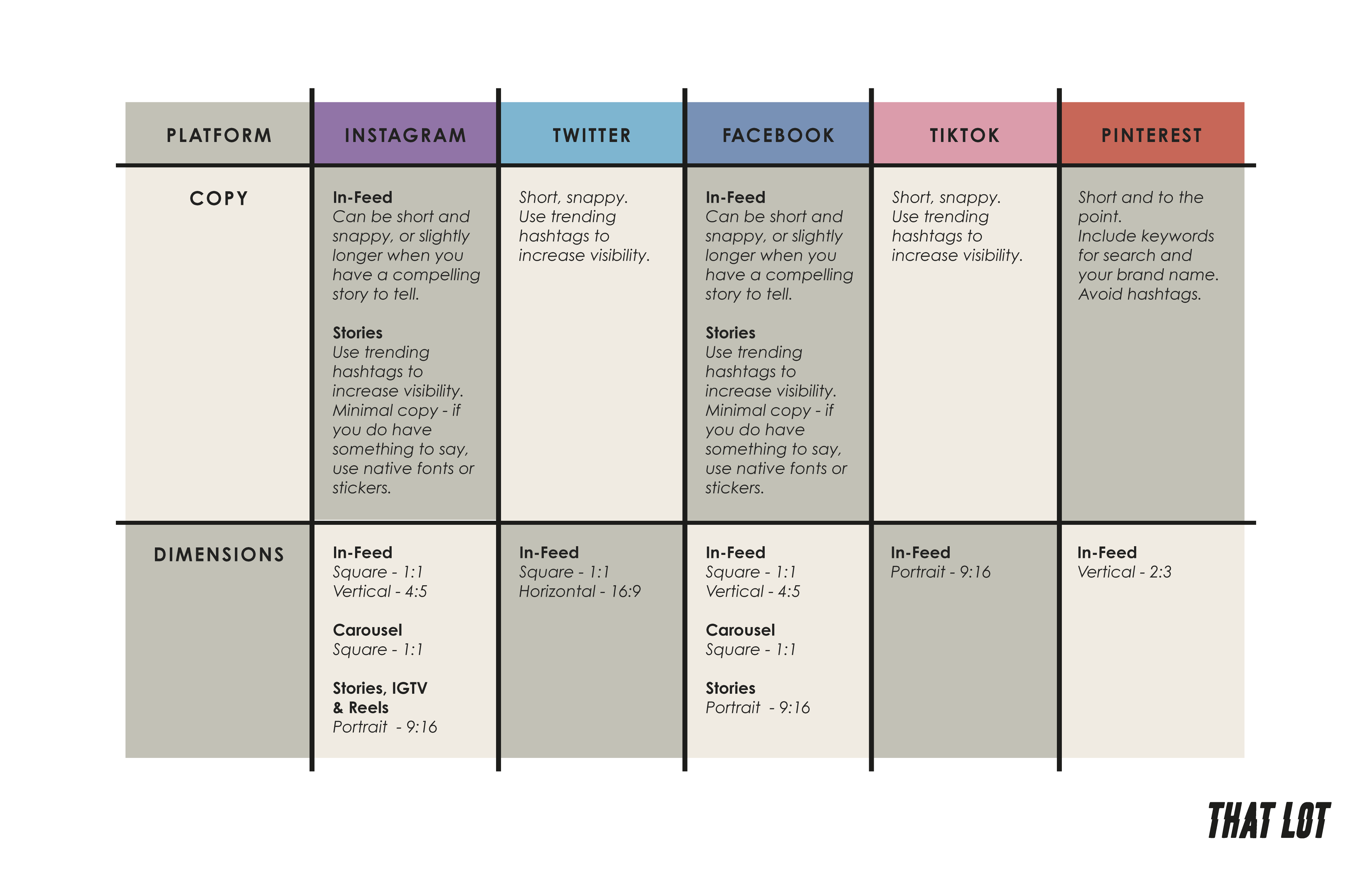
How to win at social media
During the pandemic, as well as baking lots of bread, we socialised online more than ever before. Craving connection, people turned to their favourite platforms to fill the void of IRL interaction, and we witnessed social media return to its original purpose - to connect and build communities. Brands have jumped at the opportunity to use the power of social to get closer to their customers and with one in four saying their favourite brands have strived to build relationships with them in the past six months, it’s clearly paying off. But getting your customers to engage with you, or even notice you, on social media in today’s pay-to-play landscape requires more than just pressing ‘post’.
KNOW WHO YOU ARE
Before you even think about creating a Facebook page or Instagram profile, it’s crucial to understand who your brand is from a personality perspective. Putting some time aside to work out how you want to come across on social media will pay off in the long term, giving you a better chance of standing out and not getting lost in the sea of noise.
Broken down, understanding your brand character takes a few forms. First and foremost, you need to work out your purpose. Why are you on social media? And what value are you going to add to both your business and your customers by being there? For you it might be increasing sales, but a constant hard sell for your customers is an instant turn off (and puts you dangerously in ‘unfollow’ territory), so you need to do more than push product. Every moment people spend with your content should be worth it, so how can you add value beyond improving your bottom line? This can usually be split into three buckets: to educate, to inspire and to entertain. Do one or two of these play to your business strengths or USPs particularly well? If so, start to think about how you can show up in those ways.
Secondly, you’ll need to define your tone of voice. Jot down a few descriptive words about your business and use these to get a sense of how those make you feel. Perhaps you’re local, handmade, all-natural and sustainable. These words might evoke feelings of calmness, community, and positivity. Use these pointers to build your personality. An exercise you might find helpful, that we do with our clients, is: ‘if your brand was a celebrity, who would it be?’. Your answers to that will make it easier for you to hone-in on the right tone-of-voice.
BUILD A COMMUNITY
2020 became the summer of activism, largely driven by one globally connected social community. Looking back at events such as the death of George Floyd or the US presidential election, it’s clear that the power and influence of virtual voices is not to be underestimated.
And these digital communities aren’t just influencing how we campaign for change - they’re influencing the brands we buy from too. Social media has made it easier than ever before for opinions to be shared, meaning brands are often on the outside looking in and are increasingly unable to control how and where their business is spoken about. This, combined with the fact that 92% of people trust peer recommendations over branded messaging, means that social communities are more important than ever.
To get started with building your community, you need to communicate beyond sales and talk to your audience on a personal level. Being too robotic or bland is an instant turn off. Here are our three top tips to get started:
- Community management - reply to as many comments as possible, proactively look for relevant conversations to join, and reshare user-generated content (aka UGC) that you’re tagged or mentioned in.
- Relatable content - getting involved in trending / relevant conversations is a great way to grow and retain fans on social by putting your brand front of mind in the moments that matter to your audience. The best brands on social have a deep understanding not just of themselves, but of their target audience too, so do some research - look at what your customers are creating and sharing with their own network. What does that content look like and what are they talking about? Find ways to cross those topics over with your business to create content you know they’re going to be interested in.
- Leverage brand advocates - brand advocates can be employees, customers, or influencers. Establishing them starts first and foremost offline with the quality of your product or service, but once you’ve nailed that, use social media to supercharge advocacy and transform happy customers into passionate fans. Think about offering customers rewards or incentives to share reviews, or even surprise those who have given positive feedback with small tokens like vouchers or gift codes. Be sure to create a bespoke hashtag or ask people to tag you so you can find posts that mention you further down the line.
CREATE THUMB-STOPPING CONTENT
Before covid, the average person scrolled through 300 feet, or one Statue of Liberty, of mobile content every day. And since then, our time spent on social media has increased by 8%, meaning we’re wading through even more. With the average human attention span now shorter than a goldfish (ouch), it’s a huge challenge to get your message across.
To stand out, you need to give your audience a reason to stop scrolling. Think about ways to disrupt the standard feed of posts in a way that’s different and impactful, but still native to the platform and compliant with existing visual language. Confused? Let’s break it down…
First off, to catch someone’s eye and be memorable you need to be consistently distinctive. I bet you know instantly what brand I’m talking about when I say, for example, golden arches. What are your unique brand assets? That one or two little things that are recognisably yours. Maybe, like the grocery delivery service @weezy.co.uk, it’s the font you use. Or like skincare brand @starface, perhaps it’s your product. Whatever it is, the trick here is to use your distinctive assets in a way that’s truly social first - rather than slapping your logo over an image, think about how you can weave your unique assets into photographs or images in a natural way.
Secondly, to be impactful, you need to give people a reason to stop and engage. Unlike traditional 30 second TV ads, story arcs on social media are not linear. With most people spending just 1.7 seconds on the average piece of content (even shorter for younger audiences!), you need to find that hook that pulls people in instantly. This is usually achieved through sparking emotion or working from a relatable truth.
Finally, lean into existing visual formats and trends you know your audience are already familiar and engaging with. From memes and polls to mirror selfies and #smallbusinesscheck, borrow from popular styles to create content that adds to, rather than detracts from, your communities’ online experience.

BE PLATFORM SPECIFIC
People use different platforms for different reasons. And that means what works best for TikTok isn’t going to work as well for Twitter. Think about why your customers are there and what they’re there for, and create content based on those observations - what’s the best format, context, and message? Again, look at what your audience are up to and mirror that behaviour. People appreciate when brands do this because it gives them a better experience.
You definitely don’t have to be on every platform. Choose wisely. Think about what your business offers, where your customers are spending their time and the type of content you can realistically create as some platforms require a greater investment of money and time than others.
Being on a few different platforms doesn’t mean creating something completely different and unique for each and every channel but tweaking copy and changing dimensions should be the very basic boxes you’re ticking to increase the chance of people engaging with your posts and not reaching for that ‘unfollow’ button. Keep this simple table to hand for best practice guidance:

BE SMART WITH YOUR MEDIA
Whilst following the tips we’ve outlined should supercharge the shareability of your content, social media giants continue to deprioritise organic brand posts and it’s harder than ever to get eyeballs on your content without paying for those eyeballs.
But you don’t need bazillions to promote your content. Be smart with your media budget and a little can go a long way. Follow these top tips:
- Define your audience - trying to sell without knowing your target audience is like driving with your eyes closed (please never do that). Audience profiles help you define who you’re talking to and serve people ads they are more likely to take notice of. Think about the commonalities shared by your desired customers - this can be demographic data like age, gender, location, income etc, shared interests or behaviours, such as previous purchases and device usage. Use this information to build a target audience profile to increase the relevance of your ads.
- Define your marketing goals and match those with your campaign objectives. If you’re a small business, it’s likely that you’ll want to raise awareness of your brand and products, so buying on an awareness-based objective is a good place to start. Once you’ve built awareness you can then start to think about retargeting your existing audience with content that progresses them down the funnel to considering and ultimately converting to purchase.
- Test, learn, repeat - most social media platforms offer in-depth insights into the performance of your ads. These are like gold dust - they can help you understand why something did or didn’t perform well and what changes you can make to increase the impact of your content next time. If you have the budget, AB testing is a great way to do this live - trial different copy lines, creative rules (i.e., an image with text overlay vs without), formats etc.

A final word…
While all of these tips will help get you started, social media moves at the speed of lightning. The landscape is constantly changing, and with new formats and features released almost daily, and platforms like TikTok making the lifespan of trends increasingly fleeting, the biggest takeaway here is to keep your finger on the pulse. That means immersing yourself in social media culture - keep an eye on what people are talking about, what the platforms are up to and what your competitors are doing. Stay a step ahead and don’t get left behind.

